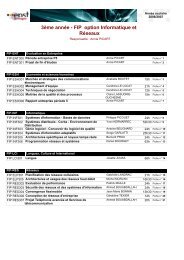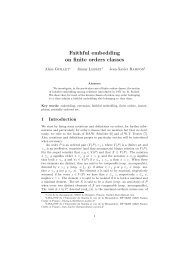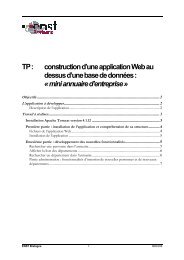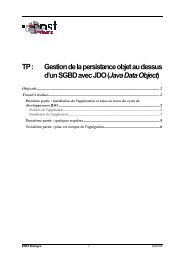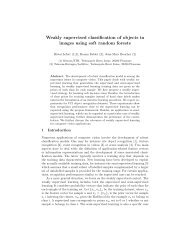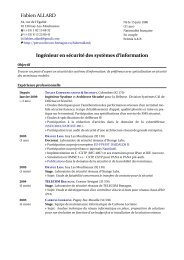researResearch - Télécom Bretagne
researResearch - Télécom Bretagne
researResearch - Télécom Bretagne
Create successful ePaper yourself
Turn your PDF publications into a flip-book with our unique Google optimized e-Paper software.
h Research<br />
9<br />
RESEARCH<br />
specifically to convolutional turbo decoders.<br />
Thus, the subject evolves around two research<br />
areas: algorithmical aspects of turbo-decoding<br />
systems and architectural aspects of their<br />
numeric design.<br />
Concerning the algorithmical part, this work<br />
presents a wide range of investigations of<br />
parallelism in convolutional turbo decoding.<br />
These investigations are based on three-level<br />
classification of parallelism techniques, which is<br />
constructed according to their granularity and<br />
acceleration abilities. Analysis of this<br />
classification reveals that sub-block parallelism<br />
and component-decoder parallelism need efforts<br />
to improve the implementation efficiency. Our<br />
researches enlighten that sub-block parallelism<br />
becomes more efficient with the message<br />
passing initialisation technique. Additionally, we<br />
show that component-decoder parallelism with<br />
shuffled decoding improves the efficiency of<br />
highly parallelized turbo-decoder architecture.<br />
Furthermore, we present how to optimise this<br />
efficiency through constraints interleaver design.<br />
Concerning the architectural part, algorithmical<br />
results were integrated in a multiprocessor<br />
platform exploiting the tradeoffs between<br />
hardware and software (i.e.<br />
performance/flexibility) at processing and<br />
communication levels. To cope with processing<br />
tradeoffs, we propose a Application-Specific<br />
Instruction-set Processor (ASIP) dedicated to<br />
turbo-decoding of convolutional codes. The<br />
designed ASIP provides the required flexibility<br />
while enabling high-throughput thanks to a<br />
highly parallelized datapath. At the<br />
communication level, our multi-ASIP platform<br />
exploits dedicated network on chip in order to<br />
ensure the bandwidth required for iterative<br />
exchange of information. The resulting multi-<br />
ASIP platform was prototyped on emulation<br />
board based on FPGA.<br />
The flexibility of the proposed platform enables<br />
the support of all existing and emerging<br />
standards of convolutional turbo-codes, and have<br />
industrial applications in mobile and satellitebased<br />
communications, broadcasting, Internet<br />
high-throughput.<br />
5. Adaptive Network-on-Chip<br />
Architecture Design for Turbo-<br />
Receivers<br />
Multiprocessor platforms constitute a promising<br />
architectural solution for the design of highthroughput<br />
flexible turbo-receivers. Besides<br />
application algorithm optimizations and<br />
application-specific processor design, the onchip<br />
communication network connecting the<br />
multiple on-chip cores constitutes a major issue.<br />
Conventional on-chip buses become inefficient in<br />
large systems and the nanotechnology<br />
integration issues (propagation delay, crosstalk,<br />
etc.) make their use no more practical. In this<br />
context, Network-on-Chip has recently emerged<br />
as a new paradigm allowing to cope with these<br />
major design issues. It consists of adapting the<br />
modular, scalable, and flexible<br />
hardware/software architectures and design<br />
tools of Network domain to the context of silicon<br />
integration.<br />
Our aim in this project is to propose an adaptive<br />
network-on-chip architecture allowing efficient<br />
multiprocessor turbo-receiver implementation.<br />
The proposed NoC architecture should efficiently<br />
accommodates the intensive and random<br />
extrinsic information exchange between the<br />
iterative processing components. It should<br />
enable communication-resource management<br />
and adapt according to the application mode or<br />
standard, environment, and QoS requirements.<br />
In this context, appropriate application-specific<br />
NoC topologies, routing algorithms, resource<br />
management techniques, and software network<br />
layers are being proposed. On-chip<br />
communications can be designed while applying<br />
a completely ad hoc methodology or with generic<br />
bus-based or NoC-based solutions. The first one<br />
provides dedicated optimal solution but does not<br />
offer the flexibility required by industry for<br />
reprogramming, standard updates or IP reuse.<br />
The second approach is flexible but can lead to<br />
over-sized solutions, which are not acceptable<br />
for cost and energy reasons. Most of current NoC<br />
are firstly designed independently from<br />
applications, and in a second step they are<br />
tailored to meet application constraints. Our<br />
approach in this research thematic is firstly<br />
based on application analysis.<br />
53






